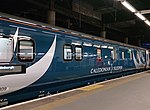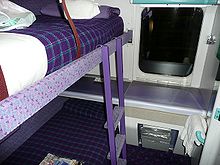Caledonian Sleeper
| Caledonian Sleeper | |
|---|---|

|
|
| Basic information | |
| Concession and duration |
Independent franchise of Serco operates 31 March 2015 until today |
| Parent company | Serco |
| statistics | |
| fleet | 6 British Class 73 Electric Diesel Locomotive 2 British Class 86 Electric Locomotive 1 British Class 87 Electric Locomotive 7 British Class 92 Electric Locomotive 22 British Class Mark 2 Passenger Cars 53 British Class Mark 3 Passenger Cars |
| Train stations | 46 |
| Main lines |
West Coast Main Line Edinburgh to Aberdeen Line Highland Main Line West Highland Line |
| Branch lines | - |
| website | |
| sleeper.scot | |
Caledonian Sleeper is the name of two night trains in the United Kingdom between Scotland and London . One of the train pairs connects London with Glasgow and Edinburgh ("Lowlander"), the other carries wagons between London and Aberdeen , Inverness and Fort William ("Highlander"). Together with a night train between London and Penzance, they are the last remaining night trains in Great Britain. From 2004 to 2015 they were operated by First ScotRail , and since 2015 the railway company Serco Caledonian Sleepers , a subsidiary of the service company Serco , has been the contracted operator.
history
The first sleeping cars between London and Scotland were already running in 1873. With the privatization of British Rail in 1994, most of the sleeping car connections in Great Britain, such as the sleeper train between Plymouth and Scotland, were discontinued . The planned termination of the last sleeper trains between Scotland and London was prevented by vehement public protests from Scottish peers and large landowners as well as hikers and railway fans. Together with the Night Riviera from London to Penzance , the two remaining pairs of trains on the Caledonian Sleeper are now the only night trains in the United Kingdom.
When the regional Scottish franchise ScotRail was awarded for the first time in 1997, the night train service previously operated by British Rail was taken over by National Express . In 2004 National Express lost the Scottish franchise and with it both train routes of the Caledonian Sleeper when it was reassigned to First , which continued to operate the night trains as part of First ScotRail largely unchanged. Due to the old wagon material with its increasing vulnerability and rising maintenance costs, the continuation of the Caledonian Sleeper was initially at risk with the planned expiry of the First franchise in April 2015. Chancellor of the Exchequer George Osborne then offered to provide £ 50 million through HM Treasury , the UK Treasury, for the purchase of new rolling stock , if the Scottish government secured the remaining financing with its own funds. The Scottish government finally decided to continue the night train and separate it from the rest of the Scotrail franchise.
In May 2014, the Scottish Ministry of Transport awarded the services to Serco as an independent franchise for 15 years from April 2015 . Linked to this is the procurement of 72 new wagons from the Spanish manufacturer CAF , which should be used from summer 2018. Serco started operations on April 1st, 2015, with problems with bookings in the first week. From autumn 2015, GB Railfreight should also take over traction services on DB Schenker's diesel routes. Nicola Sturgeon , the First Minister of Scotland, unveiled the new logo of the Caledonian Sleeper, a stylized white deer, shortly before the start of operations at the end of March in the new Serco customer center in Inverness. Contrary to the original plans, the new rolling stock was only used from April 2019. From April 28, the pair of trains between London and Edinburgh / Glasgow was converted to the new fleet of vehicles, the pair of trains between London and Aberdeen / Inverness / Fort William was originally supposed to follow in July 2019. Due to significant technical problems with the introduction of the new wagons, Serco decided in June 2019 not to convert the second pair of trains until September 2019 and initially to ensure reliable operation of the new wagons for the first pair of trains. The change had initially led to Serco becoming the least punctual train operator ( TOC ) in Great Britain.
Timetable offer
There are two trains in each direction every day, except on Saturdays. A train travels from Euston Station in London on the West Coast Main Line (with stops at Watford Junction , Crewe and Preston ) and is split into three parts at Edinburgh Waverley Station, serving Inverness , Aberdeen and Fort William . He is therefore also known as "Highland Caledonian Sleeper" or "Highlander", the branch after Fort William also called "The Deerstalker" (after deer hunting widespread in the Scottish Highlands ), but does not officially bear this name. The drive from Inverness to London takes exactly twelve hours. The second train leaves London a little later and after stops in Watford Junction and Carlisle at the Scottish Carstairs train station, southeast of Glasgow, it is split into two parts in the direction of Edinburgh and Glasgow. Since both destination stations are in the Lowlands , the names "Lowland Caledonian Sleeper" or "Lowlander" have become established.
Vehicle fleet
The Caledonian Sleeper cars have one and two-bed compartments as well as open plan cars with reclining seats. A bar and dining car called a lounge car is also carried along. The fleet comprises a total of 75 cars. 11 of these are seating carriages with reclining seats or lounge carriages. 12 of the 53 sleeping cars are wheelchair accessible . By 2019, the fleet of vehicles built in 1972 construction was Mark2 , and design from 1980 to 1984 delivered Mark3 since newly acquired vehicles are of the type Mark 5 used by the Spanish manufacturer CAF were delivered. All cars are equipped with air conditioning . Alstom has been entrusted with the maintenance and repair work, which uses facilities in London and Polmadie near Glasgow.
The locomotives have generally been provided by GB Railfreight since 2016 ; the company won the relevant tender in 2015. By 2016, the were on the non-electrified lines still locomotives Class 67 of DB Schenker used. In addition to the series 73/9 (on the lines without contact wire) and 92 (on the electrified sections), which are mainly used by Railfreight, other types are used for shunting and transfer journeys as well as in the event of failure of the regular locomotives.
| Existing vehicles | ||||||
|---|---|---|---|---|---|---|
| model series | image | Type | V / max | number | Construction year | Operational routes |
| Class 73/9 |

|
Electric diesel locomotive | 145 km / h | 6th | 1962, 1965–1967 (renovation 2014–2016) |
Edinburgh - Inverness / Aberdeen / Fort William |
| Class 92 |

|
Electric locomotive | 140 km / h | 7th | 1993-1996 | London - Glasgow / Edinburgh |
| British Class Mark 5 (CAF) |

|
Sleeping car dining car seating car with reclining seats |
161 | 75 | 2016-2018 | Total distance |
Others
The Caledonian Sleeper is particularly popular with visitors to the Highlands, as the train section to Fort William also goes to small, otherwise difficult-to-reach destinations, such as Corrour station in Rannoch Moor, which is inaccessible by public roads . The train sections from Glasgow and Edinburgh are popular with Scottish politicians on their trips to London: The passengers included the first First Minister of Scotland Donald Dewar , the former Prime Minister Gordon Brown , the former leader of the Labor Party , John Smith and the former Scotland Minister Danny Alexander . Lonely Planet rated the train as one of the best eight night trains in Europe in 2011.
Web links
Individual evidence
- ^ The Guardian: A comfortable way to get from A to Zzzz, September 29, 2006 , accessed February 11, 2016
- ↑ railfuture-sw.co.uk: Cross Country History, The Campaign for SW to NW CrossCountry Trains ( Memento of the original from June 22, 2012 in the Internet Archive ) Info: The archive link was inserted automatically and has not yet been checked. Please check the original and archive link according to the instructions and then remove this notice. , accessed February 11, 2016
- ↑ a b BBC News: The 1980s time-warp of the London-Scotland sleeper train, June 1, 2014 , accessed February 11, 2016
- ^ Transport Scotland: Scottish Transport Statistics No 35: 2016 Edition, Chapter 7: Rail Services , accessed January 7, 2019
- ^ The Independent: Goodnight to the sleeper train, November 21, 2011 , accessed February 11, 2016
- ↑ a b London reconnections: The (Caledonian) Sleeper Awakes , accessed February 11, 2016
- ↑ BBC News: Serco wins franchise for Caledonian sleeper train service, May 28, 2014 , accessed January 6, 2015
- ↑ Herald Scotland: Booking glitch causes chaos for Caledonian Sleeper tourists reserved "non-existent" coaches , April 8, 2015 , accessed April 23, 2015
- ↑ Rail magazine: Sturgeon unveils new look Caledonian Sleeper at Inverness , March 24, 2015 , accessed April 23, 2015
- ↑ pd / fsch: Caledonian Sleeper with new rolling stock , in: Eisenbahn-Revue International 7/2019, p. 368
- ↑ Gwyn Topham: Caledonian Sleeper suffers setbacks with Highlands train delay , The Guardian , June 26, 2019, accessed July 19, 2019
- ↑ sleeper.scot - Timetables (English) accessed on April 23, 2015
- ^ National Rail Inquiries: Sleeper trains , accessed February 11, 2016
- ↑ sleeper.scot - lounge car (English) accessed on April 23, 2015
- ↑ www.railtechnologymagazine.com: Caledonian Sleeper fleet maintenance contract extended , February 13, 2015 , accessed on August 10, 2020
- ↑ www.railwaytechnologymagazine.com: GB Railfreight wins contract to haul Caledonian Sleepers , February 18, 2015 , accessed on June 12, 2017
- ^ Lonely Planet: Europe's 8 best night trains. May 10, 2011 , accessed February 11, 2016


